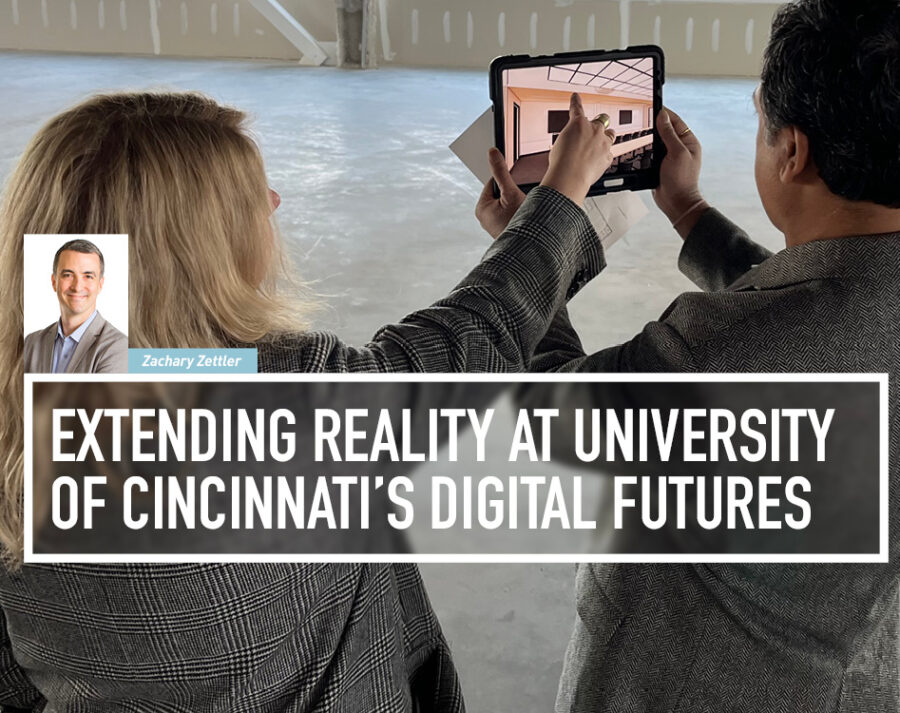Insights
May 21, 2024 _ insights
Extending Reality at University of Cincinnati’s Digital Futures
How do you represent a three-dimensional space in just two dimensions? This is a fundamental problem in design that architects and their clients have struggled with for a long time.
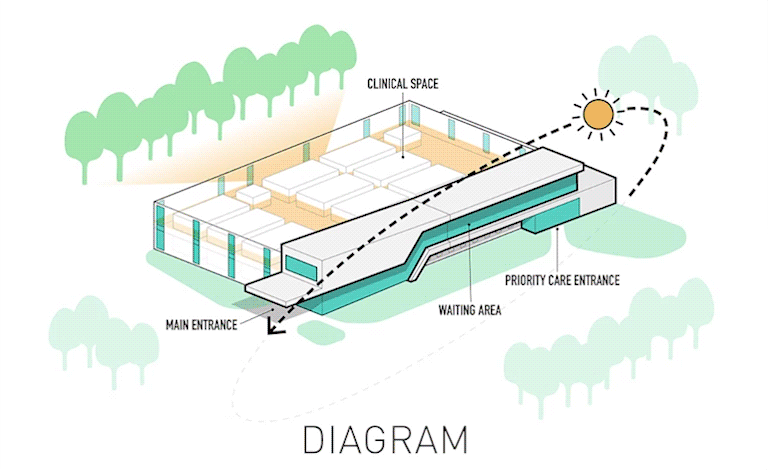 Over its history, architecture has developed many workarounds to communicate what a space will look and feel like before it is built. These include diagrams, technical drawings (such as floor plans and sections) as well as renderings. But fluency with these communication tools can vary widely within project teams. This is especially true in higher education, where members of campus planning departments and end-users (faculty, researchers, departmental staff) have very different levels of training and experience, and thus each team member may have a different understanding of the design solution.
Over its history, architecture has developed many workarounds to communicate what a space will look and feel like before it is built. These include diagrams, technical drawings (such as floor plans and sections) as well as renderings. But fluency with these communication tools can vary widely within project teams. This is especially true in higher education, where members of campus planning departments and end-users (faculty, researchers, departmental staff) have very different levels of training and experience, and thus each team member may have a different understanding of the design solution.
Extended Reality offers a solution
Extended Reality (XR) is an umbrella term that refers to Augmented Reality (AR), Virtual Reality (VR), Mixed Reality (MR), and other technologies that use the human/screen interface to situate their users in an immersive environment.
What’s especially promising about the architectural application of these technologies is that they can immerse end-users in a full-scale 3D model of an unbuilt space that is pulled directly from the existing model. This taps into an intuitive and embodied sense of space that helps less-experienced users bridge the interpretive gap between the drawings and the unbuilt reality.
Experimenting with AR + VR
In partnership with the University of Cincinnati’s (UC) Office of Research and Office of Planning + Design + Construction, we recently used a combination of AR and VR to engage end-users and contractors in the ongoing buildout of Digital Futures.
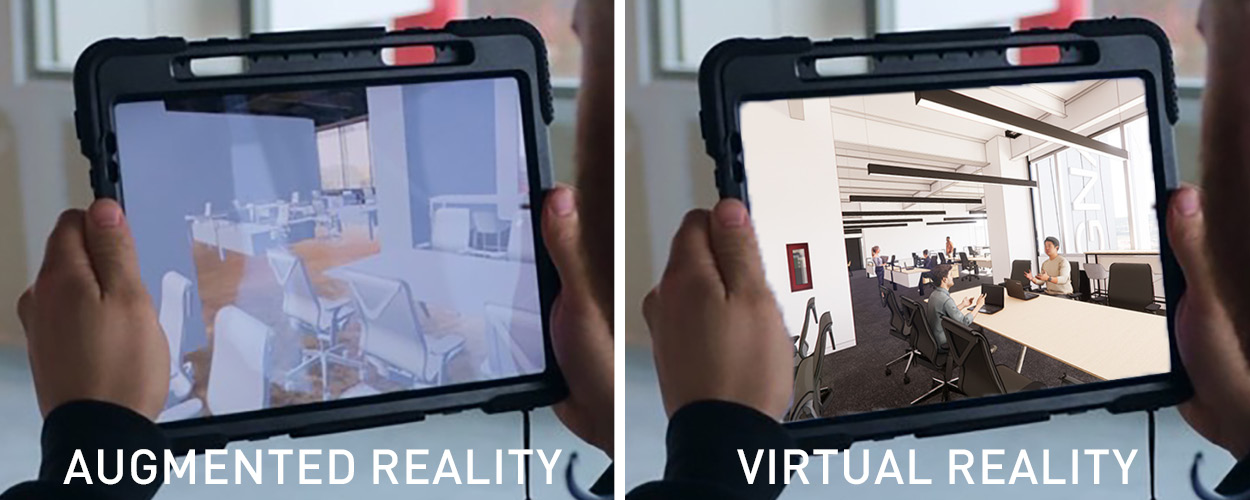
AR (left), overlays proposed design elements onto actual, unfinished space as users move around in that space. VR (right) is a stationary experience but with 360° rendered representation. Both have their advantages and when paired together they elevate the other.
UC’s first purpose-built interdisciplinary research building, Digital Futures, opened in Fall 2022 with the charge of “solving problems that matter.” The buildout of two remaining floors of shell space provided the perfect opportunity for GBBN and UC to experiment with XR-driven improvements to the design process.

As UC’s Associate Vice President for Research, Strategic Programs, & Initiatives, Jennifer Krivickas, put it, “It’s so fitting that GBBN partnered with UC Research at the Digital Futures building to leverage advanced tech to push the boundaries of architectural design and client engagement—after all, the very philosophy of Digital Futures is partnership, moonshot thinking, and tech-enabled research and discovery for impact at scale. GBBN has identified a real business problem, and their creative, experimental approach aims to solve it.”
Partnership + Risk Taking
When we gathered with the project team from UC on an empty floor of Digital Futures to explore an AR model of that floor, it wasn’t our first time deploying AR on this scale. However, it is still a relatively new application of this technology, so it was productive to do so with a long-established partner, and one who fully embraces new technology in their own day-to-day work. The researchers from UC who joined us are also experienced with AR, so when we ran into some trouble associated with a weak Wi-Fi signal and a large file size, they took it all in stride. They knew we were relying on a signal from another floor, and they understood how the technology works.
Fortunately, after some creative problem solving, we were able to overcome a few technical glitches and provide the end-users with an immersive experience of their space.
Improving Feedback & Enhancing Construction
Building on previous experiences with AR, we anticipated that it would help us solicit better, more informed feedback. And it did. As end-users explored their space on iPads, they were able to identify improvements that they would like to see.
For instance, Associate Professor, Dr. Swastick Brahma noticed that the placement of a couple of large monitors interrupted a line of sight across the lab, leaving a portion of it feeling disconnected. This observation prompted a design update that removed the monitors, creating a more flexible and fluid lab space. Of course, the information about the placement and dimensions of the monitors was already available in drawings that the project team had reviewed, but the experience of seeing things documented on paper is so different from seeing it in space.
It’s not surprising that experiencing a design in an immersive environment raises issues that were not apparent before. Fortunately, it is much easier and less expensive to address those concerns before the space is built, and an AR model can be pulled from the design software very early in the design process to facilitate these improvements.
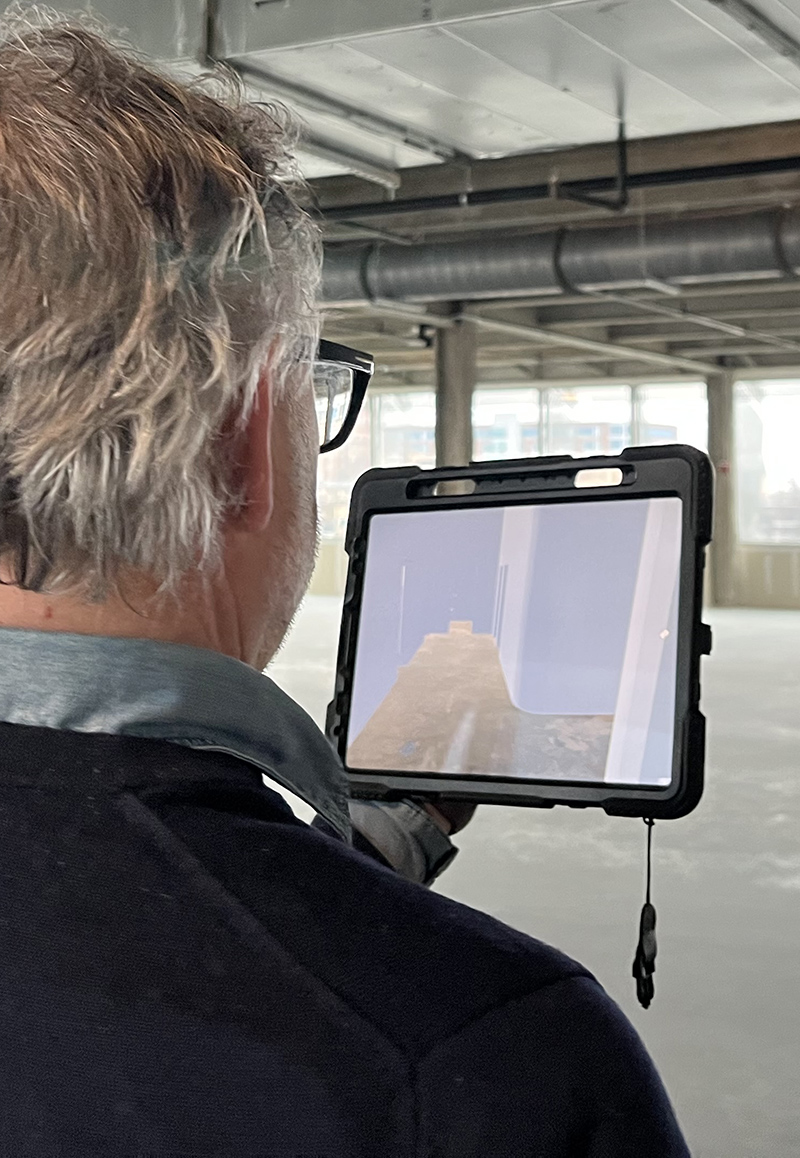 Later in the design process, we can use AR to engage construction partners in in-depth conversation about the project. Two weeks after our walkthrough with UC’s team, we revisited the floor with the construction manager, HGC. This allowed us to communicate critical design intent and discuss concerns about details that might require extra care before they established the Guaranteed Maximum Price (GMP) and began construction. This not only helps the contractors, but it benefits the client by tackling any construction issues that might cause delays or price increases before they arise.
Later in the design process, we can use AR to engage construction partners in in-depth conversation about the project. Two weeks after our walkthrough with UC’s team, we revisited the floor with the construction manager, HGC. This allowed us to communicate critical design intent and discuss concerns about details that might require extra care before they established the Guaranteed Maximum Price (GMP) and began construction. This not only helps the contractors, but it benefits the client by tackling any construction issues that might cause delays or price increases before they arise.
In the meantime, we were also able to work with our partners at Fologram, whose software hosts our AR models, to test some blocking/instancing-improvements that significantly reduced file size and improved the performance of the model.
A Virtual Supplement
While AR enables our clients to move through a model of a 3D space, the size of the model (in gigabytes, not square footage) can be limiting. At this point in the evolution of the technology, the AR models we use tend to be rather stripped down.
We’re not using AR to show our clients how the space will feel (its specific details, acoustic treatments, etc.), but instead to show them where the walls and furnishings will be and how they interact with one another.
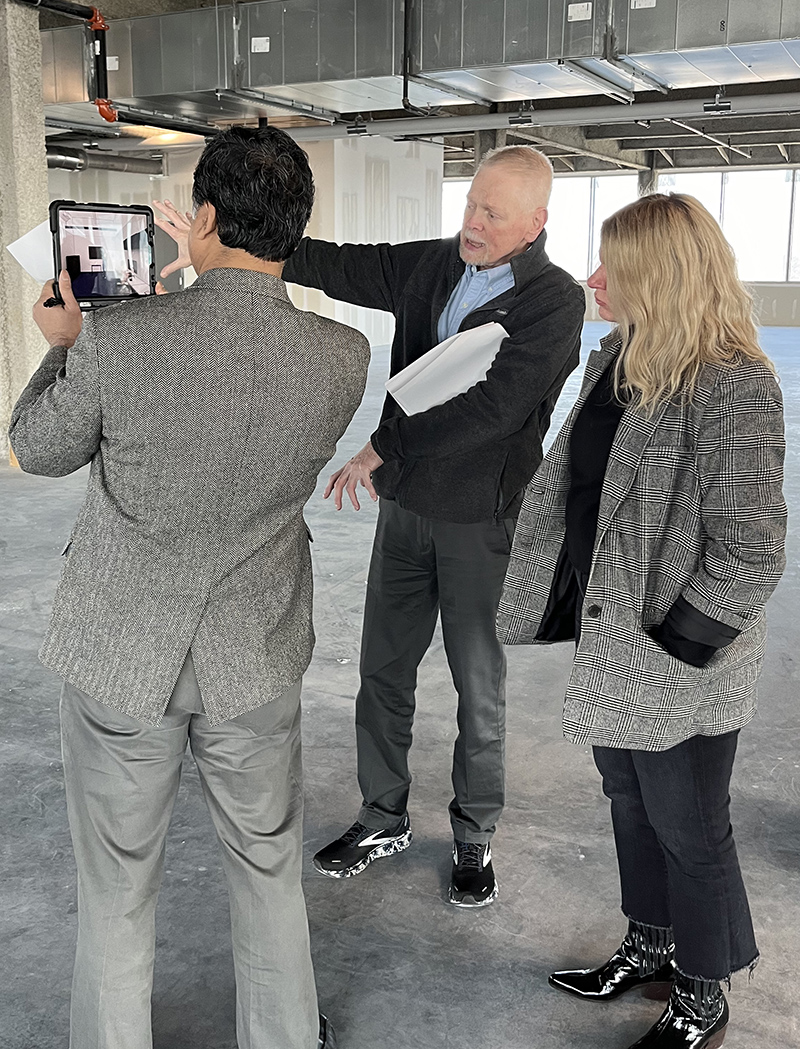 At Digital Futures, we supplemented the AR model in key locations with a series of 360° VR, showing office chairs and high tops, wallcoverings, light pendants, and more. So, as end-users navigated the AR space through their iPads, there were some locations where they could scan a QR code to access a richly textured and fully immersive view of what the finished space will look like. They couldn’t move through the VR view in the same way, but it gave them a richer level of detail.
At Digital Futures, we supplemented the AR model in key locations with a series of 360° VR, showing office chairs and high tops, wallcoverings, light pendants, and more. So, as end-users navigated the AR space through their iPads, there were some locations where they could scan a QR code to access a richly textured and fully immersive view of what the finished space will look like. They couldn’t move through the VR view in the same way, but it gave them a richer level of detail.
It is easy to imagine a future in which AR becomes more capable of supporting the detail-rich imagery of VR, but for now we find that their differences are productive. While AR feels more abstract than VR, it helps to focus the designers’ and clients’ attention on spatial relationships (lines of sight, the juxtaposition of workspaces, etc.). In other words, it prevents the conversation from diving into details about finishes and paint colors, and instead emphasizes operations and function of the space.
In this respect, AR and VR are like the many other drawing and imaging technologies that architects use. From floor plans to elevations, watercolor renderings to computer generated images, each communication tool has its own strength and purpose.
Through their ability to speak to clients’ embodied experience and spatial knowledge, AR and VR—more broadly, XR—provide excellent new tools for improving feedback from clients, anticipating construction and maintenance issues, and ensuring that the final space serves end users’ needs. It is evident that the ways of communicating the 3-dimensional aspects of space have significantly improved over the past decade. We expect the next generation of these tools to be even more powerful. This progress is a welcome development because it better connects our clients’ vision to reality.

Zachary Zettler, AIA, LEED AP is GBBN’s Director of Higher Education. With over 20 years’ experience designing campus spaces, Zachary is a trusted advisor to our university clients and a recognized leader in higher education design. Zachary’s work includes University of Cincinnati’s Digital Futures, University of Cincinnati’s Marian Spencer Hall, Case Western Reserve University’s Susi First-Year Experience Lab, and University of Pittsburgh’s Hillman Library Transformation. He has published insights on repurposing campus spaces and predictive analytics in university masterplans and is frequently invited to speak at regional and national conferences.
